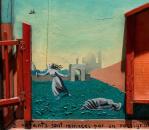Two Killers Haunt 1950s London in ‘Death in the Air’

Death in the Air: The True Story of a Serial Killer, The Great London Smog and the Strangling of a City
Kate Winkler Dawson
Hachette
320 pages
In December 1952, a toxic haze of smog and fumes descended on London, so deadly it was linked to more than 1,000 deaths in four days. At the same time, equally horrifying in its own way, a nondescript serial murderer was in the midst of a years-long killing spree. Ultimately, at least four women would die by his hand, possibly an infant as well.
The account of these twin occurrences plaguing England’s capital is the subject of Death in the Air, a new “true crime” account by veteran journalist Kate Winkler Dawson.
Compounding the dual tragedy was the fact that Great Britain was still emerging from the ravages of the Second World War. Living conditions were dire. Food was still rationed. And winters were very, very cold.
For most citizens, inexpensive coal was the only source of fuel in those bad years. As Winkler notes, almost every home contained at least one coal fireplace:
“The fuel was cheap, effective, and crucial—it was the only major source of domestic heating in the city at that time. But the smoke could be suffocating, and the sulphur dioxide released into the air was deadly. It triggered acid rain strong enough to bend iron, erode statues, poison land, and contaminate waterways—the pollution could destroy lungs and cause cancer. But still the coal burned.”
British industry produced better-quality black coal that fetched greater profits overseas, with little left over to benefit the nation’s own people. Instead, everyone relied on an inferior black coal called “nutty slack”—easy to burn and extremely polluting, but “all that most Londoners could afford in those desperate postwar times.”
Then, in the waning weeks of the year, natural forces took a turn for the worse. A freak high-pressure weather system stalled in the air, bringing down a blanket of darkness and causing the great metropolis to grind to a halt:

“The Underground was deluged with passengers, but trains sat on the tracks; the weather delayed service by hours … Thousands of street gas lamps were sparked and it was still almost impossible to navigate empty roads. Drivers abandoned their cars on the streets, like frightened teenagers hiding from a ghoul in an American horror film.”
Meanwhile, in his Notting Hill flat, an unremarkable city transportation clerk named Reginald Christie quietly continued a series of grisly murders begun nearly a decade before. He preyed on vulnerable women, suffocating them (as the air itself asphyxiated thousands) and eluding detection by the authorities for an absurdly long time.
Winkler describes these disparate events in impressive detail. She offers a chilling description of how abysmal government policies, combined with a bout of truly terrible weather, created the slaughterhouse effects of 1952. She writes with verve and sympathy about a handful of Christie’s victims, and seems to capture with disturbing accuracy the killer’s mental state as he commits and then hides the evidence of his monstrous crimes.
At places in the book, the narrative falters. Extended accounts of meetings in Parliament (to debate smog bill legislation) sometimes read like the minutes of a local city council meeting. And there’s a thin strand connecting the citywide deaths by smog with those of a single murderer who’d been quietly perfecting his craft for years before the extreme weather event.
But for capturing the quality of day-to-day life during those few hellish days, Winkler’s prose is outstanding. A young woman named Rosemary dares to go outside during the worst of it:
“She could see the small particles floating, even without a real breeze. The bus windows were screwed tight, but that smell haunted her—acrid, filthy, and burning, like taking a whiff from the inside of a chimney’s brick throat. The heavier the cloak of fog, the more it burned. It scorched her eyes and her nose, and then squeezed her throat. On the street, trendy debutantes wrapped their chiffon scarves across their mouths, their pearls dangling just below, in a futile effort to stop the rancid air from choking them. But even their upscale woolen coats wouldn’t cut the chill on this day.”
Millions of Londoners experienced this all-encompassing torment during the last days of 1952. Many never survived the ordeal.
Author Bio:
Lee Polevoi, Highbrow Magazine’s chief book critic, has just completed a new novel, The Confessions of Gabriel Ash.
For Highbrow Magazine





























































































































































































































































































































